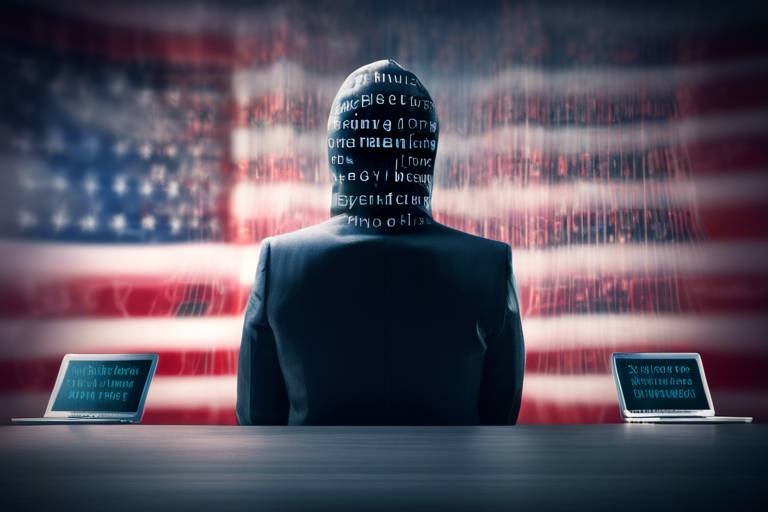Cybersecurity and Politics - What You Need to Know
In an era where our lives are increasingly intertwined with technology, the relationship between cybersecurity and politics has become more critical than ever. Imagine a world where a single cyberattack could sway the outcome of a national election or compromise sensitive government data. This is not merely a dystopian scenario; it’s a reality we face today. As political landscapes evolve, so do the tactics employed by cybercriminals, making it essential for us to understand the implications and challenges that arise in this complex interplay.
Cybersecurity is no longer just a concern for tech-savvy individuals or large corporations; it has become a matter of national interest. The digital age has given rise to new threats that can alter the course of political events. From data breaches that expose voter information to sophisticated disinformation campaigns that manipulate public perception, the potential for cyber threats to disrupt democratic processes is alarming. As citizens, we must be vigilant and informed about these challenges to ensure the integrity of our political systems.
The stakes are high, and the players are numerous. Governments, political parties, and even grassroots organizations are all potential targets of cyberattacks. This makes understanding the landscape of cybersecurity not just important, but imperative. With every election cycle, we witness a surge in cyber activity, with hackers seeking to exploit vulnerabilities in political campaigns and government infrastructures. The need for robust cybersecurity measures has never been more pressing.
To navigate this complex terrain, political entities must adopt a proactive approach to cybersecurity. This involves not only implementing advanced technologies but also fostering a culture of awareness and preparedness among staff. Training programs that educate employees about potential threats and best practices can significantly reduce the risk of successful attacks. Moreover, developing incident response plans ensures that organizations are ready to act swiftly in the event of a breach, minimizing potential damage.
As we delve deeper into this topic, we will explore various aspects of cybersecurity in politics, including notable case studies of cyber attacks, the role of government in establishing cybersecurity frameworks, and the future challenges that lie ahead. By understanding these elements, we can better appreciate the intricate dance between cybersecurity and politics, and the measures needed to safeguard our democratic values.
- What is the primary goal of cybersecurity in politics?
The main goal is to protect sensitive information, maintain the integrity of electoral processes, and ensure national security against cyber threats. - How can political entities prepare for cyber threats?
By implementing comprehensive cybersecurity strategies, conducting risk assessments, and providing employee training on cybersecurity best practices. - What role does the government play in cybersecurity?
Governments establish policies, provide resources, and foster public-private partnerships to enhance national security against cyber threats. - Why is international cooperation important in cybersecurity?
Cyber threats are global in nature, and international collaboration is essential to effectively combat these threats and protect democratic processes worldwide.

The Intersection of Cybersecurity and Politics
Understanding how cybersecurity influences political decisions and vice versa is crucial in today's digital age. The intertwining of these two fields has become increasingly evident, especially in an era where a single data breach can sway the outcome of an election or compromise national security. Just think about it: a hacker infiltrates a political campaign's database, steals sensitive voter information, and suddenly, the integrity of the entire electoral process is called into question. This scenario isn’t just a plot from a futuristic movie; it’s our reality.
In this digital landscape, political entities are not just fighting for votes but also for the trust of the public. When cybersecurity fails, it doesn't just affect the campaign; it can lead to widespread disillusionment among voters. The implications of cyber threats are profound, as they can lead to manipulation of public perception through misinformation campaigns. To put it simply, if you control the information, you control the narrative. This is why understanding the intricate relationship between cybersecurity and political landscapes is not just important; it’s essential.
Moreover, as we navigate this complex environment, we must consider the various cyber threats that political campaigns face. From phishing attacks targeting campaign staff to sophisticated social engineering tactics aimed at misdirecting public opinion, the threats are numerous and evolving. The challenge lies in not only identifying these threats but also in developing effective strategies to combat them. For instance, political organizations must prioritize cybersecurity training for their staff, ensuring that everyone understands the importance of safeguarding sensitive information.
As we explore this intersection further, it's essential to recognize that the relationship between cybersecurity and politics is not a one-way street. Political decisions can also influence cybersecurity measures. For example, legislation aimed at enhancing cybersecurity protocols can lead to more robust defenses for political campaigns. Conversely, political unrest can lead to an increase in cyberattacks as malicious actors exploit vulnerabilities during times of chaos. This dynamic relationship means that both fields must work in tandem to protect democratic processes.
In summary, the intersection of cybersecurity and politics is a complex and multifaceted issue that requires ongoing attention and action. As we move forward, the importance of establishing strong cybersecurity measures within political entities cannot be overstated. The stakes are high, and the consequences of inaction can be devastating. As we delve deeper into this topic, we will uncover the various challenges and strategies that political organizations must adopt to navigate this ever-evolving landscape.
- What is the impact of cyber threats on political campaigns? Cyber threats can disrupt campaigns, steal sensitive information, and manipulate public perception, ultimately affecting election outcomes.
- How can political entities protect themselves from cyberattacks? By implementing comprehensive cybersecurity strategies, including employee training and incident response plans.
- What role does government play in cybersecurity? Governments establish cybersecurity policies, provide resources, and foster collaboration between public and private sectors to enhance national security.

Cyber Threats in Political Campaigns
In today's hyper-connected world, political campaigns are not just about rallies, speeches, and debates anymore. They are increasingly becoming battlegrounds for cyber threats. As campaigns strive to reach voters through digital platforms, they also expose themselves to a myriad of dangers lurking in the shadows of the internet. Hackers, state-sponsored actors, and even rogue individuals are constantly on the lookout for vulnerabilities to exploit. But what exactly are these threats, and how do they impact the political landscape?
One of the most alarming aspects of cyber threats in political campaigns is the potential for data breaches. Imagine a hacker infiltrating a campaign's database, stealing sensitive information like donor lists, internal communications, or strategic plans. This not only compromises the integrity of the campaign but also puts the personal data of supporters at risk. Such breaches can lead to devastating consequences, including the loss of public trust and the manipulation of campaign narratives.
Moreover, the rise of misinformation campaigns has transformed the way political information is disseminated. Hackers and malicious actors can create fake news, deepfake videos, or misleading social media posts that can sway public opinion and disrupt electoral processes. It’s like throwing a smoke bomb into a crowded room; people are left confused and misled, often without realizing it. The challenge for campaigns is to combat these tactics while maintaining their message and protecting their reputation.
To illustrate the gravity of these threats, consider the following table that highlights some common cyber threats faced by political campaigns:
| Cyber Threat | Description | Potential Impact |
|---|---|---|
| Data Breaches | Unauthorized access to sensitive campaign data. | Loss of trust, financial repercussions, and strategic disadvantages. |
| Misinformation Campaigns | Spreading false information to manipulate public perception. | Voter confusion and potential shifts in electoral outcomes. |
| Phishing Attacks | Attempts to trick campaign staff into revealing sensitive information. | Compromise of accounts and sensitive data leaks. |
| Denial of Service (DoS) Attacks | Overloading campaign websites to disrupt operations. | Inability to communicate with voters and potential loss of donations. |
As we can see from the table, the implications of these cyber threats are profound. Campaigns must be proactive in their approach to cybersecurity. This means not only investing in robust security measures but also fostering a culture of awareness among staff. Regular training sessions on recognizing phishing attempts and understanding the importance of data security can go a long way in fortifying a campaign's defenses.
In conclusion, as political campaigns continue to evolve in the digital age, so too do the threats they face. The intersection of cybersecurity and politics is fraught with challenges, but with the right strategies and a commitment to safeguarding sensitive information, campaigns can navigate these turbulent waters. The stakes are high, and the consequences of inaction could be detrimental not just for the campaigns themselves but for the democratic process as a whole.
- What are the most common cyber threats in political campaigns?
Common threats include data breaches, misinformation campaigns, phishing attacks, and denial of service attacks.
- How can political campaigns protect themselves from cyber threats?
Campaigns can enhance their cybersecurity by implementing robust security measures, conducting regular staff training, and developing incident response plans.
- Why is misinformation a significant threat in political campaigns?
Misinformation can manipulate public opinion, create confusion, and undermine the integrity of the electoral process.

Case Studies of Cyber Attacks
The digital landscape is fraught with peril, especially for political entities that find themselves in the crosshairs of cybercriminals. Understanding the tactics and motivations behind these attacks is essential for developing effective defenses. Let's explore some notable case studies that highlight the vulnerabilities and consequences of cyber attacks on political institutions.
One of the most infamous examples is the 2016 U.S. Presidential Election, where cyber intrusions not only targeted political campaigns but also sought to manipulate public perception. Hackers infiltrated the Democratic National Committee (DNC) and leaked sensitive emails that revealed internal conflicts and strategic missteps. This breach not only damaged the DNC's reputation but also raised significant concerns about the integrity of the electoral process. The fallout from this incident was immense, leading to a national conversation about election security and the role of foreign interference.
Another striking case occurred in Estonia in 2007, where a series of cyber attacks targeted government and financial institutions following a political dispute with Russia. The attacks, which included distributed denial-of-service (DDoS) assaults, crippled online services and highlighted the vulnerabilities of a nation heavily reliant on digital infrastructure. This incident served as a wake-up call for many countries about the importance of cybersecurity in protecting national interests.
Internationally, the 2019 Indian General Elections faced significant cyber threats, with reports of misinformation campaigns and hacking attempts aimed at influencing voter behavior. The Indian government took proactive measures by collaborating with tech companies to monitor and counteract these threats. This case showcased the need for vigilance and preparedness in the face of evolving cyber tactics.
As we analyze these incidents, several patterns emerge regarding the tactics used by malicious actors:
- Phishing Attacks: Many cyber attacks begin with phishing attempts, where attackers trick individuals into revealing sensitive information.
- Data Breaches: Unauthorized access to databases can result in the theft of sensitive information, which can be used to manipulate public opinion.
- Misinformation Campaigns: The spread of false information can sway public perception and disrupt the democratic process.
These case studies underscore the pressing need for political organizations to prioritize cybersecurity. By learning from past attacks, they can better prepare themselves to defend against future threats. The stakes are high; as we have seen, a single cyber attack can have far-reaching implications, not just for a political entity but for the entire democratic process.
Q1: What are the common types of cyber attacks targeting political entities?
A1: Common types include phishing attacks, data breaches, and misinformation campaigns, all of which aim to disrupt operations or manipulate public perception.
Q2: How can political organizations improve their cybersecurity?
A2: They can adopt comprehensive strategies that include regular risk assessments, employee training, and robust incident response plans.
Q3: What role do governments play in protecting against cyber threats?
A3: Governments establish cybersecurity policies, provide resources, and foster collaboration between public and private sectors to enhance national security.

2016 U.S. Presidential Election
The stands as a pivotal moment in the intersection of cybersecurity and politics, illustrating how digital vulnerabilities can have profound effects on democratic processes. As the election unfolded, it became clear that cyber intrusions were not just a backdrop but a central theme that shaped voter perceptions and trust. Hackers targeted various political entities, employing tactics that ranged from data breaches to sophisticated disinformation campaigns. These activities raised alarming questions about the integrity of the electoral process and the resilience of our democratic institutions.
One of the most notable incidents involved the hacking of the Democratic National Committee (DNC), which led to the release of thousands of emails that painted a negative picture of the party's inner workings. This breach not only disrupted the DNC's operations but also influenced public opinion, as the leaked information was strategically timed to maximize impact. The fallout from these hacks was significant, with many voters questioning the legitimacy of the election outcomes and the security of the voting process itself.
Moreover, the 2016 election showcased the power of social media as a tool for both campaigning and misinformation. Hackers and foreign entities exploited platforms like Facebook and Twitter to spread false narratives and create divisions among the electorate. This manipulation of information was not merely a side effect; it was a calculated strategy aimed at undermining public trust in the electoral system. The ability to influence voter behavior through targeted ads and misleading information campaigns highlighted a new frontier in political warfare.
To better understand the implications of these cyber threats, let’s take a look at some key statistics surrounding the 2016 election:
| Incident | Description | Impact |
|---|---|---|
| DNC Hack | Unauthorized access to DNC emails and documents | Loss of trust in party leadership |
| Social Media Manipulation | Spread of misinformation through targeted ads | Polarization of voter opinions |
| Election Day Cyber Attacks | Attempts to disrupt voting systems | Concerns over election integrity |
This convergence of cybersecurity and politics during the 2016 election emphasizes the urgent need for political entities to bolster their defenses against cyber threats. As we look to the future, it is crucial to implement comprehensive cybersecurity strategies that not only protect sensitive information but also ensure the integrity of our electoral processes. The lessons learned from this election serve as a reminder that in the digital age, safeguarding democracy requires vigilance, resilience, and proactive measures to counteract the evolving landscape of cyber threats.
- What were the main cyber threats during the 2016 election? The main threats included hacking of political organizations, disinformation campaigns on social media, and attempts to disrupt voting systems.
- How did the DNC hack affect voter trust? The DNC hack led to the release of sensitive information, which undermined public confidence in the party's leadership and raised concerns about the integrity of the election.
- What steps can political entities take to enhance cybersecurity? Political entities should conduct risk assessments, provide employee training, and develop incident response plans to mitigate cyber threats.

International Election Interference
The phenomenon of has emerged as a pressing concern in the digital age, where the boundaries of national sovereignty are increasingly blurred by technology. This interference often manifests through cyber attacks, misinformation campaigns, and covert operations aimed at undermining the integrity of electoral processes across the globe. Countries are not just fighting for their own political stability but are also facing threats from foreign entities seeking to manipulate outcomes for their own strategic advantages.
One of the most notable examples of this interference occurred during the 2016 U.S. Presidential Election, where evidence surfaced indicating that foreign actors, particularly from Russia, had engaged in a coordinated effort to disrupt the electoral process. This included hacking into email accounts of political figures, leaking sensitive information, and disseminating fake news across social media platforms to sway public opinion. Such tactics not only raised alarms about the security of elections but also highlighted the vulnerabilities inherent in the digital infrastructure of democratic systems.
Moreover, international election interference is not limited to the United States. Countries like France, Germany, and the UK have also reported attempts by foreign powers to meddle in their electoral processes. For instance, during the French presidential election in 2017, hackers targeted Emmanuel Macron's campaign, leaking documents in an attempt to damage his credibility. These incidents underscore a growing trend; as technology evolves, so do the methods of interference, making it imperative for nations to bolster their cybersecurity measures.
To combat these threats, nations must engage in collaborative efforts to share intelligence and best practices. The establishment of international coalitions focused on cybersecurity can help create a unified front against these malicious activities. Additionally, countries should invest in technology that can detect and neutralize threats before they materialize. This might include advanced algorithms capable of identifying patterns of misinformation or detecting anomalous activities in electoral databases.
In conclusion, the challenge of international election interference is a complex issue that requires a multifaceted approach. As we navigate through this digital landscape, it’s crucial for governments to prioritize cybersecurity and work together to safeguard the sanctity of elections worldwide. The future of democracy hinges on our ability to protect it from those who seek to undermine it through cyber means.
- What is international election interference? - It refers to foreign efforts to influence or disrupt the electoral processes of another country, often through cyber attacks and misinformation.
- How can countries protect themselves from election interference? - Countries can enhance their cybersecurity measures, invest in technology to detect threats, and collaborate with international partners to share intelligence.
- What are some examples of election interference? - Notable instances include the 2016 U.S. Presidential Election and the 2017 French presidential election, where foreign actors attempted to manipulate public perception and disrupt campaigns.

Preventative Measures for Political Entities
In today’s digital age, political entities face an array of cyber threats that can jeopardize not only their operations but also the democratic processes they uphold. To combat these risks, it's essential for political organizations to implement robust preventative measures. These strategies encompass a comprehensive approach that includes risk assessments, employee training, and incident response plans.
First and foremost, conducting regular risk assessments is critical. By identifying vulnerabilities within their systems, organizations can prioritize resources and address the most pressing threats. This practice is akin to a doctor performing regular check-ups to catch health issues before they escalate. Political entities should evaluate their digital infrastructure, data storage practices, and third-party vendors to ensure that every potential entry point for cyber intrusions is secured.
Moreover, employee training is a vital component of a successful cybersecurity strategy. Often, human error is the weakest link in the security chain. By educating staff about the latest cyber threats, phishing scams, and safe online practices, organizations can significantly reduce the risk of breaches. Think of it as teaching a community how to recognize and avoid dangerous wildlife—awareness can prevent disastrous encounters. Regular workshops and simulations can help reinforce this knowledge, ensuring that employees remain vigilant against evolving threats.
Another crucial measure is the development of a comprehensive incident response plan. This plan serves as a roadmap for organizations to follow in the event of a cyber attack. It should outline clear roles and responsibilities, communication strategies, and recovery procedures. Without a well-defined plan, political entities may struggle to respond effectively, resulting in prolonged downtime and potential data loss. A well-prepared organization can respond to incidents swiftly, minimizing damage and restoring public trust.
In addition to these measures, political organizations should also consider implementing advanced technologies such as intrusion detection systems and encryption protocols. These tools can provide real-time monitoring and protect sensitive information from unauthorized access. Furthermore, engaging in regular security audits can help ensure that all systems remain compliant with the latest cybersecurity standards.
Finally, collaboration with other political entities, as well as with cybersecurity experts, can enhance overall security. Sharing best practices and intelligence about emerging threats creates a network of defense that is harder for cybercriminals to penetrate. Just like a neighborhood watch program, collective vigilance can deter potential threats and foster a culture of security awareness.
In summary, the landscape of cybersecurity is constantly evolving, and political entities must stay ahead of the curve. By adopting a multifaceted approach that includes risk assessments, employee training, incident response plans, and advanced technologies, organizations can fortify their defenses against cyber threats. These preventative measures not only protect sensitive information but also uphold the integrity of the democratic processes they represent.
- What are the most common cyber threats faced by political entities?
Political entities often face threats such as phishing attacks, ransomware, and data breaches that can compromise sensitive information. - How often should political organizations conduct risk assessments?
Risk assessments should be conducted at least annually, or more frequently if significant changes occur in technology or operations. - Why is employee training important in cybersecurity?
Employees are often the first line of defense against cyber threats; training helps them recognize and respond to potential risks effectively. - What should be included in an incident response plan?
An incident response plan should include roles and responsibilities, communication strategies, recovery procedures, and a timeline for response actions.

The Role of Government in Cybersecurity
In today’s hyper-connected world, the role of government in cybersecurity has never been more critical. With the rise of cyber threats that can disrupt not just individual organizations but entire nations, governments are stepping up to establish comprehensive policies aimed at protecting their citizens and infrastructure. This involves a multi-faceted approach that includes legislation, collaboration with private sectors, and the development of robust cybersecurity frameworks.
One of the primary responsibilities of government is to create cybersecurity legislation that defines standards and protocols for both public and private entities. This legislation is essential for ensuring that all organizations, especially those critical to national security, adhere to strict guidelines. For instance, laws can mandate the implementation of encryption for sensitive data and require regular security audits. Such regulations not only help in safeguarding information but also hold organizations accountable in the event of a breach.
Moreover, governments are tasked with protecting critical infrastructure, which includes everything from power grids to communication networks. A well-known example is the Cybersecurity and Infrastructure Security Agency (CISA) in the United States, which works tirelessly to secure these vital systems. The agency provides resources, guidance, and support to both public entities and private companies, ensuring that they are prepared to face potential cyber threats.
Another significant aspect of government involvement in cybersecurity is the promotion of public-private partnerships. The collaboration between government agencies and private companies is crucial for sharing threat intelligence and resources. By working together, they can create a more resilient cybersecurity landscape. For example, when a new vulnerability is discovered, timely sharing of information can help organizations implement necessary defenses before they become targets. This collaboration often takes the form of joint exercises, workshops, and information-sharing platforms that enhance overall readiness against cyber threats.
To illustrate the impact of government efforts, consider the following table that outlines key components of effective cybersecurity governance:
| Component | Description |
|---|---|
| Legislation | Establishes legal standards and accountability for cybersecurity practices. |
| Infrastructure Protection | Focuses on safeguarding critical systems essential for national security. |
| Public-Private Partnerships | Facilitates collaboration for enhanced threat intelligence sharing. |
| Education and Training | Promotes awareness and skill development in cybersecurity best practices. |
Furthermore, governments also play a vital role in educating the public about cybersecurity risks and best practices. By launching awareness campaigns and training programs, they empower citizens to protect themselves against cyber threats. This is particularly important as the line between personal and professional data continues to blur, and individuals must be vigilant in their online activities.
In conclusion, the role of government in cybersecurity is multifaceted and essential for safeguarding national interests. From crafting legislation to fostering collaboration and promoting public awareness, governments are at the forefront of the fight against cyber threats. As the cyber landscape continues to evolve, so too must the strategies employed by governments to ensure that they can effectively protect their citizens and maintain the integrity of democratic processes.
- What is the primary role of government in cybersecurity? The government is responsible for establishing legislation, protecting critical infrastructure, and fostering collaboration between public and private sectors to enhance national security.
- How do public-private partnerships benefit cybersecurity? These partnerships facilitate the sharing of threat intelligence and resources, creating a more resilient cybersecurity environment for all organizations.
- Why is cybersecurity legislation important? Legislation sets standards and protocols that organizations must follow, ensuring accountability and enhancing overall security measures.

Legislation and Regulation
In the ever-evolving landscape of cybersecurity, play a critical role in shaping how political entities protect themselves against cyber threats. Governments around the world recognize that without a robust legal framework, the integrity of democratic processes could be compromised. The establishment of cybersecurity laws is not just about creating rules; it's about fostering a culture of accountability and transparency among political organizations.
One of the primary objectives of cybersecurity legislation is to define clear standards for data protection. These standards are essential for safeguarding sensitive information, especially in politically charged environments where the stakes are high. For instance, regulations can mandate that political campaigns implement specific security measures, conduct regular risk assessments, and report any data breaches promptly. This creates a chain of responsibility that can help mitigate the fallout from cyber incidents.
Moreover, legislation serves as a deterrent against cybercriminals. When potential attackers know that there are strict laws and penalties in place, they may think twice before attempting to breach a political entity's systems. This is particularly important in the context of foreign interference, where malicious actors might exploit vulnerabilities to undermine democratic processes. By establishing clear legal repercussions for cyber offenses, governments can send a strong message that such actions will not be tolerated.
However, creating effective legislation is not without its challenges. Policymakers must strike a balance between implementing necessary regulations and ensuring that they do not stifle innovation or infringe on civil liberties. For instance, while it is crucial to monitor digital communications for potential threats, it is equally important to protect citizens' privacy rights. This delicate balance requires ongoing dialogue between lawmakers, cybersecurity experts, and civil society.
Furthermore, the global nature of cyber threats necessitates international cooperation in legislation. Cybercriminals often operate across borders, making it essential for countries to collaborate on legal frameworks that can effectively address these challenges. Initiatives such as the Budapest Convention on Cybercrime aim to foster international cooperation by establishing common standards for combating cybercrime. Such collaborative efforts can enhance the overall security posture of political entities worldwide.
In summary, legislation and regulation are vital components of a comprehensive cybersecurity strategy for political entities. By establishing clear standards, creating accountability, and fostering international cooperation, governments can better protect their democratic processes from the ever-present threat of cyber attacks.
- What is the role of legislation in cybersecurity? Legislation helps define standards for data protection, establishes accountability, and deters cybercriminals by imposing legal repercussions for breaches.
- How can international cooperation enhance cybersecurity? By collaborating on legal frameworks and sharing best practices, countries can better address cross-border cyber threats and improve overall security.
- What challenges do lawmakers face in creating effective cybersecurity legislation? Policymakers must balance the need for security with the protection of civil liberties, ensuring that regulations do not stifle innovation.

Public-Private Partnerships
In the realm of cybersecurity, the synergy between the public and private sectors is not just beneficial; it’s essential. As cyber threats evolve at an alarming pace, the collaboration between government entities and private organizations creates a formidable defense against malicious actors. Think of it as a well-oiled machine where each cog plays a vital role in maintaining the integrity of our digital infrastructure. By sharing resources, expertise, and threat intelligence, both sectors can bolster their defenses and respond more effectively to incidents.
One of the primary benefits of public-private partnerships in cybersecurity is the ability to pool knowledge and resources. For instance, government agencies often have access to advanced threat data and intelligence that can help private companies understand the broader landscape of cyber threats. Conversely, private companies can offer innovative technologies and real-time data that can enhance government capabilities. This mutual exchange can lead to the development of cutting-edge solutions designed to thwart cyber attacks before they can cause significant damage.
Moreover, these partnerships can facilitate the establishment of best practices and standards that are crucial for protecting critical infrastructure. By working together, public and private entities can create comprehensive frameworks that ensure all stakeholders are equipped to handle potential threats. This collaboration can take various forms, including:
- Joint Training Exercises: Regular drills and simulations can prepare both sectors for potential cyber incidents.
- Information Sharing Platforms: Establishing secure channels for sharing threat intelligence can enhance situational awareness.
- Incident Response Teams: Collaborative teams can respond swiftly to breaches, minimizing damage and restoring services.
However, while the benefits are clear, challenges also exist. Trust is a critical component of these partnerships, and both sectors must be willing to share sensitive information without fear of misuse. Additionally, the regulatory landscape can sometimes complicate these collaborations, as compliance with various laws and regulations can create barriers to information sharing.
To illustrate the effectiveness of public-private partnerships, consider the Cybersecurity and Infrastructure Security Agency (CISA) in the United States. CISA has established numerous initiatives that encourage collaboration between government and private sectors. Through programs like the Cybersecurity Information Sharing Act (CISA), organizations can share information about cyber threats while receiving protection from liability. This not only enhances national security but also fosters a culture of cooperation and proactive threat mitigation.
In conclusion, as cyber threats continue to escalate, the importance of public-private partnerships in cybersecurity cannot be overstated. By leveraging each other’s strengths, both sectors can create a robust defense mechanism that not only protects sensitive information but also safeguards the democratic processes that rely on it. The future of cybersecurity depends on this collaborative spirit, paving the way for a more secure digital landscape.
1. What are public-private partnerships in cybersecurity?
Public-private partnerships in cybersecurity refer to collaborations between government agencies and private companies to enhance security measures, share threat intelligence, and develop best practices for protecting digital infrastructure.
2. Why are these partnerships important?
These partnerships are crucial because they combine resources and expertise from both sectors, leading to more effective responses to cyber threats and the establishment of comprehensive security frameworks.
3. What challenges do public-private partnerships face?
Challenges include trust issues regarding information sharing, regulatory compliance, and the need for a unified approach to cybersecurity standards.
4. How can organizations get involved in public-private partnerships?
Organizations can engage by participating in government initiatives, joining information sharing platforms, and collaborating on cybersecurity training exercises.

The Future of Cybersecurity in Politics
As we look ahead, the landscape of cybersecurity in politics is set to undergo significant transformations. The rapid pace of technological advancement means that political entities must stay one step ahead of cybercriminals who are constantly innovating their tactics. Imagine a game of chess where your opponent is not only incredibly skilled but also has the ability to change their strategy at a moment's notice. This is the reality for political organizations trying to safeguard their data and maintain public trust.
With the rise of new technologies such as artificial intelligence (AI) and machine learning, the potential for both defense and attack in the cyber realm has expanded exponentially. AI can be harnessed to detect anomalies and threats in real-time, providing political institutions with the ability to respond swiftly to potential breaches. However, the same technology can also be weaponized by malicious actors to automate and enhance their attacks, making it a double-edged sword.
Moreover, the increasing reliance on social media and digital platforms for political campaigning introduces new vulnerabilities. Misinformation campaigns can spread like wildfire, undermining the integrity of elections and eroding public trust. In this context, political entities need to prioritize digital literacy among their teams and constituents alike. Educating voters about how to identify credible information sources is as crucial as securing their data.
Another critical aspect of the future of cybersecurity in politics is the emphasis on collaboration and information sharing. As cyber threats become more sophisticated, no single entity can tackle them alone. Governments, political organizations, and tech companies must work together, sharing insights and best practices to create a more resilient cybersecurity framework. This collaboration can take many forms, including:
- Joint training exercises to prepare for potential cyber incidents.
- Establishing a centralized platform for reporting and analyzing cyber threats.
- Creating public awareness campaigns to educate citizens about cybersecurity risks.
Furthermore, the future will likely see an increase in regulatory measures aimed at strengthening cybersecurity protocols within political organizations. Governments around the world are recognizing the need for robust cybersecurity legislation that not only defines standards but also holds entities accountable for breaches. This regulatory framework will serve as a foundation for building trust with the public, ensuring that political institutions are taking the necessary steps to protect sensitive information.
As we navigate this evolving landscape, one thing is clear: the future of cybersecurity in politics will require a proactive approach. It’s not just about defending against attacks; it’s about anticipating them. Political organizations must invest in cutting-edge technologies, enhance their cybersecurity training programs, and foster a culture of security awareness among their staff and constituents. The stakes are high, and the cost of inaction could be dire.
Q1: How can political organizations prepare for future cyber threats?
A1: Political organizations can prepare by investing in robust cybersecurity measures, conducting regular risk assessments, and providing ongoing training for their staff on the latest cyber threats and mitigation strategies.
Q2: What role does technology play in future cybersecurity efforts?
A2: Technology plays a dual role; it can be used to enhance security measures through AI and machine learning, but it can also be exploited by cybercriminals. Staying updated on technological advancements is crucial for effective defense.
Q3: Why is public awareness important in cybersecurity?
A3: Public awareness is essential because informed citizens can better recognize misinformation and potential threats, thereby contributing to a more secure political environment.
Frequently Asked Questions
- What is the relationship between cybersecurity and politics?
The relationship between cybersecurity and politics is increasingly intertwined. In today's digital age, the security of information can influence political decisions and outcomes. Cyber threats can disrupt elections and sway public opinion, making it crucial for political entities to prioritize cybersecurity measures.
- How do cyber threats impact political campaigns?
Cyber threats pose significant risks to political campaigns. Hackers may target campaigns to steal sensitive information, disrupt operations, or spread misinformation. This can undermine voter trust and alter the dynamics of the electoral process, making robust cybersecurity strategies essential for campaign success.
- Can you provide examples of notable cyber attacks on political entities?
Yes! One of the most notable examples is the cyber attacks during the 2016 U.S. Presidential Election. These intrusions not only affected the campaigns but also raised serious concerns about election integrity and voter trust. Additionally, other countries have experienced similar attacks, highlighting the global nature of cyber threats.
- What preventative measures should political organizations take?
Political organizations should implement comprehensive cybersecurity strategies, including conducting risk assessments, providing employee training, and establishing incident response plans. These measures can help mitigate risks and protect sensitive information from cyber threats.
- What role do governments play in cybersecurity?
Governments play a crucial role in establishing cybersecurity policies, providing resources, and fostering collaboration between public and private sectors. This collaboration enhances national security and helps protect political institutions from cyber threats.
- Why is cybersecurity legislation important?
Cybersecurity legislation is vital for defining standards and protecting critical infrastructure. It ensures accountability in the event of cyber incidents, particularly those affecting political entities, and helps create a safer digital environment for all.
- How do public-private partnerships enhance cybersecurity?
Public-private partnerships are essential for sharing threat intelligence, resources, and best practices. By collaborating, government agencies and private companies can create a more resilient cybersecurity landscape, making it harder for cyber threats to impact political institutions.
- What does the future hold for cybersecurity in politics?
The future of cybersecurity in politics will be shaped by evolving technology and emerging threats. Continuous adaptation and innovation will be necessary to address these challenges and protect democratic values in an increasingly digital world.



















